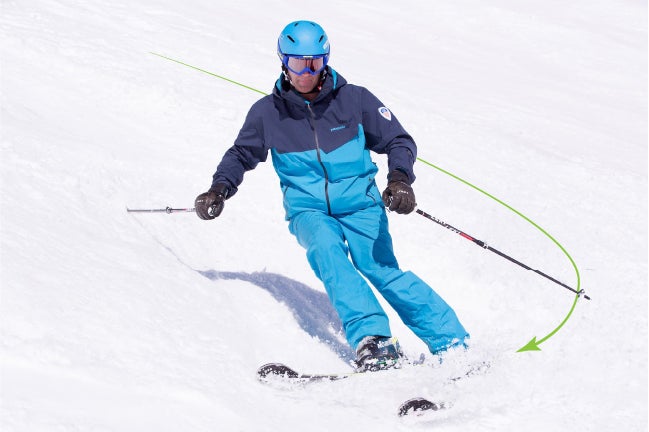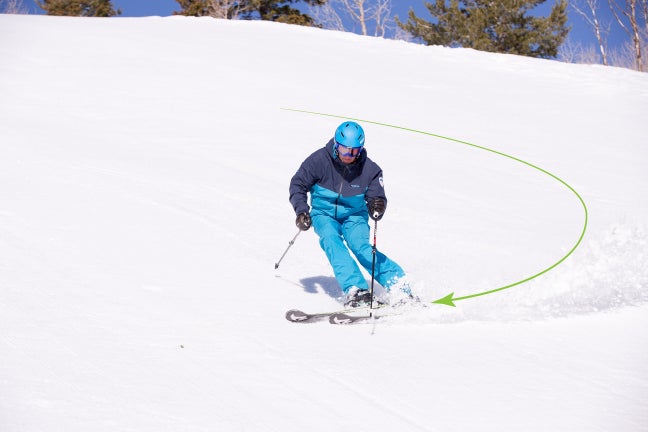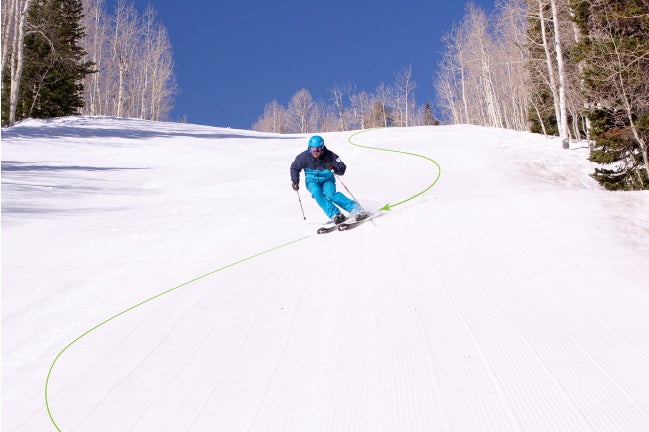Heading out the door? Read this article on the new Outside+ app available now on iOS devices for members! Download the app.
There’s skiing technique, and then there’s skiing tactics. When we talk about skiing technique, we’re referring to skills like edging, rotation, and pressure control—the skills you use to make your skis do stuff on snow. Skiing tactics, on the other hand, is a whole different set of skills that refer to how you approach any given terrain and snow conditions to ski in the most efficient way possible.
When people want to improve their skiing ability, they tend to focus on technique, like learning how to carve, how to separate their upper and lower body movements. Often skiers don’t realize that working on becoming a better tactical skier is part of becoming a better skier overall.
One of the fundamentals of smart, tactical skiing is knowing how to make different turn shapes and sizes, and when to deploy these depending on the terrain you find yourself on.
On that topic: How to ski fast and stay in control on any terrain
Most skiers naturally learn to perform the basic medium-radius turn in which skis only briefly point down the fall line before swinging across the hill. But learning how to incorporate different turn shapes and sizes into your skiing can help unlock a whole new part of the mountain, like the steeps and ungroomed terrain where that medium turns just doesn’t cut it.
“When skiing the steeps, different terrain calls for different turn sizes,” explains PSIA instructor Eric Lipton. “Short turns you’ll use when the terrain is super steep or super narrow. Long turns you’ll use on moderate pitches, or when you have a lot of wide open space to let the skis run. Medium turns you can use for everything in between.”
Related: Learn the skills you need to master the steeps with Eric Lipton and Kaylin Richardson
But the best skiers, Lipton adds, are those who can adapt turn size to the shape of the terrain, while also adding in their own flair and style. “To be a good, creative skier, you have to be able to do all three,” he says.
Turn shape is equally important, and there are three fundamental turn shapes that can help take you from the blues to the blacks and beyond. “If you want to be a good tactical skier, you’ve got to know and understand different turn shapes,” Lipton says.
Level up: Check out the steepest inbounds runs in North America
Here, Lipton and former U.S. Ski Teamer turned pro skier Kaylin Richardson break those turns down—how to perform them, and when to use them.
The J-Turn
Use: To dump speed and scope snow conditions or slope
This turn starts with your skis either pointed down the hill or just barely down the hill. Almost immediately after pushing off into the fall line, turn your skis back across the hill to come to a stop. “This turn is made for slow speeds and allows you to test the snow conditions and make sure you’re balanced before you start the run,” Lipton explains. If you’re checking out a new steep run, you can use this turn to test the pitch and snow conditions before charging downhill. “It’s like dipping your toes into the water of a lake or swimming pool before diving in,” he says.

The C-Turn
Use: To shed and control speed without coming to a full stop
As the name implies, in this turn, your turn begins and ends with skis pointing completely across the fall line to draw a “C” in the snow. “This turn allows you to maintain your speed and not accelerate as you descend the slope. Unlike the J-Turn, the C-Turn doesn’t bring you to a stop after each turn; it just allows you to keep your momentum at a consistent rate,” says Lipton. Make this your go-to turn when exploring new terrain or skiing steep slopes to carefully manage your speed.

The S-Turn
Use: To build or generate speed on wide open slopes
“I love the S-Turn. The former racer in me just loves to send it when conditions allow,” says Richardson. The S-Turn is a speed-maintaining or speed-generating turn. In this turn, skis change direction but don’t completely point across the fall line at the end of the turn before transitioning to the next. In this way, you can build some consistent momentum or even generate speed by adapting how much skis point across the fall line at the end of each turn.

Get More Tips from the Pros
7 Pro Tips to Help You Master the Fundamentals, Once and For All
Struggling With Moguls? Change the Way You Use Your Poles
No, You’re Not Supposed to Lean Back in Powder
